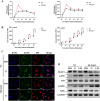The USP14-NLRC5 pathway inhibits titanium particle-induced osteolysis in mice by suppressing NF-κB and PI3K/AKT activities
- PMID: 32273344
- PMCID: PMC7242687
- DOI: 10.1074/jbc.RA119.012495
The USP14-NLRC5 pathway inhibits titanium particle-induced osteolysis in mice by suppressing NF-κB and PI3K/AKT activities
Abstract
Total hip arthroplasty (THA) is a widely-used surgical intervention for treating patients with end-stage degenerative and inflammatory osteoarthropathy. However, wear particles from the artificial titanium joint can induce osteolysis, limiting the long-term survivorship of THA. Monocyte/macrophage lineage cells are the key players in the response to wear particles, and the proinflammatory NF-κB and phosphoinositide 3-kinase (PI3K)-AKT Ser/Thr kinase (AKT)-signaling pathways have been shown to be the most important contributors to wear particle-induced osteolysis. In contrast, ubiquitin-specific protease 14 (USP14) specifically removes the polyubiquitin chains from the nucleotide-binding and oligomerization domain (NOD)-like receptor family Caspase recruitment domain (CARD)-containing 5 (NLRC5) and thereby enhances the NLRC5-mediated inhibition of NF-κB signaling. In this study, we aimed to clarify the role of the USP14-NLRC5 pathway in wear particle-induced osteolysis in vitro and in vivo We found that NLRC5 or USP14 overexpression inhibits titanium particle-induced proinflammatory tumor necrosis factor α (TNFα) production and NF-κB pathway activation, and it also decreases M1 macrophage polarization and PI3K/AKT pathway activation. Of note, NLRC5 and USP14 overexpression attenuated titanium particle-induced cranial osteolysis in mice. In conclusion, the findings of our study indicate that the USP14-NLRC5 pathway inhibits titanium particle-induced osteolysis by suppressing the NF-κB and PI3K/AKT pathways both in vitro and in vivo.
Keywords: NF-κB; NLRC5; USP14; cytokine; macrophage; osteoclast; total hip arthroplasty; tumor necrosis factor (TNF); wear particles.
© 2020 Fang et al.
Conflict of interest statement
The authors declare that they have no conflicts of interest with the contents of this article
Figures








References
-
- Jun L. R., Ke T., Long K. B., Lin Y. Y., Zhen-peng G., Dian-ge Z., and Jian-hao L. (2018) Causes and management of revision hip arthroplasty. Orthoped. J. China 26, 1729–1734
Publication types
MeSH terms
Substances
LinkOut - more resources
Full Text Sources
Research Materials

